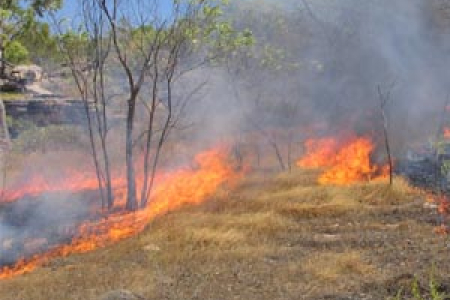Book explores future of fire in the North
The potential of using bushfire as a management tool to reduce Northern Australia’s carbon footprint is the subject of a new book to be launched at Charles Darwin University today (Wednesday, 15 July).
The book “Carbon Accounting and Savanna Fire Management”, edited by researchers from Charles Darwin University and CSIRO, brings together more than a decade of research and aims to ignite interest in the methodology of “fighting fire with fire”.
CDU Research for the Environment and Livelihoods fire ecologist Dr Andrew Edwards said that the savannas of Northern Australia were some of the world’s most flammable landscapes, providing a potentially huge market for alternate income for land managers.
“Management of fires in this region has the potential to assist with meeting emissions reduction targets, as well as conserving biodiversity and providing employment for Indigenous people in remote parts of Australia’s north,” Dr Edwards said.
The book, contributed to by many of North Australia’s pre-eminent Indigenous and non-Indigenous bushfire experts and land managers, details the extensive science underpinning the methodology used to determine carbon credits through fire management.
“We are talking about the future of land management, where managers acquire payment for ecosystem services,” Dr Edwards said. “In the context of Australia’s developing carbon economy, the methodology can be used to help abate emissions of greenhouse gases, which is an important means of generating carbon credits.”
Since its inception in 2009, the methodology has been formally accredited as part of Australia’s National Greenhouse Gas Inventory, and is increasingly being used by land managers to create strategic prescribed fire management to gain payment for ecosystem services.
“Currently there are 33 projects occurring throughout Northern Australia where land managers are applying greenhouse gas accounting methodologies to the practice of fire management, with more set to come on-board this year,” Dr Edwards said.
He said the methodology allowed land managers to improve fire management.
“The methodology takes into account vegetation type, rainfall and fire frequency, allowing land managers to calculate fuel load,” he said. “By implementing the right strategy for their property they can implement a regime that reduces frequency and intensity, which reduces the amount of fuel consumed by fire.”
The book was co-edited by Charles Darwin University’s Darwin Centre for Bushfire Research researchers Dr Brett Murphy, Dr Andrew Edwards and Professor Jeremy Russell-Smith, and CSIRO atmospheric scientist Mick Meyer.
It will be officially launched at 5:30pm on Wednesday, 15 July at CDU’s Casuarina campus, building Orange 12. See map: http://www.cdu.edu.au/sites/default/files/CASmap12.pdf
For more information visit W: publish.csiro.au/pid/7008.htm#sthash.7iu2bbbR.dpuf
